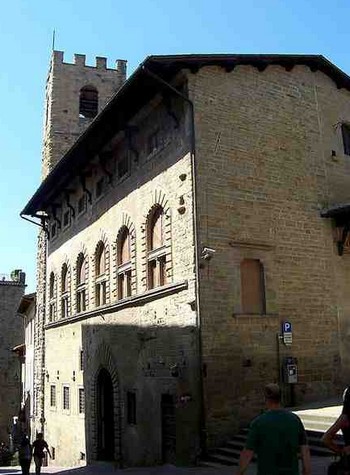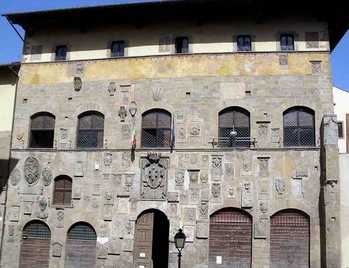Introduction
In the past year I could perform some fruitful research in Arezzo, in the Archivio Storico della Fraternita dei Laici, ASFdL: with its results, no fewer than five notes have been published.(1) Now, I expect to continue that research, even if the books that remain to be examined look somewhat less promising than those already studied.
Before beginning this second stage of my research in the ASFdL, I have realised that it was necessary to complete another study, strictly connected. As a matter of fact, I supposed that relevant basic data should be searched in two other archives, which in principle represent the best source for any relevant documentary information for Arezzo: the Archivio di Stato di Arezzo, ASAr, and the Archivio di Stato di Firenze, ASF; for historical reasons, the latter archive cannot be neglected in this research, because many documents that had their origin in Arezzo are now kept there.
1. Archivio di Stato di Arezzo
For the ASF,(2) it is not necessary to repeat here what I have already written in a previous note.(3) On the contrary, I must add some information about the ASAr,(4) because it is the first time that we meet it in my publications.
Its location is already something interesting. We had seen that the Fraternita Palace was directly located in Piazza Grande, the main square of the old Arezzo centre.(1) If we come out of the Fraternita and enter the Vasari Logge on the left, we have just to follow the same Logge out of Piazza Grande and the short Via Giorgio Vasari leads us to an interesting crossing: at a distance of few meters we see the ASAr on the left, at the corner with Corso Italia, and the Biblioteca civica on the right in Via dei Pileati (which is just the continuation of Corso Italia, upwards in direction of Duomo).
In both cases we are in front of two further valuable palaces: the ASAr is located in Palazzo Albergotti, the Biblioteca in the historically even more significant Palazzo Pretorio, with many coats of arms in stone and marble in its façade – corresponding images are easy to find at Google Images.
Providentially, I had a useful introduction to the ASAr from one of its archivists.(5) She called my attention, in particular, on its Gabelle and Camarlingo sections.
2. Gabelle
2.1 Gabelle in Arezzo
A section of the ASAr is devoted to Gabelle, or taxes. The first book of its series Tariffari has contents of remarkable interest, even if unfortunately of unknown date (it is indicated as “XV-XVI sec.”).(6)
|
“Apresso sarà lo Stratto di doghaneri et pasegeri del contado nuovamente aprovato per gli spetabili uficialli di monte et providitori et maestri di dogana”.
|
It is an official collection of the taxes to apply to a lot of merchandise, long lists of items with the money amount of the corresponding duties. All its folios are in parchment and the handwriting is clear.
Playing cards cannot be found listed here as an individual entry. However, “carte da giuchare” are included in a long list of various goods that are taxed in the same way: here is the list under examination, copied from f. 46v.
|
Mercie qui nominati e simili stochi sproni coregie cholari da choregie calzari guanti scharpette borse scharsele bracheri patenostri perle di vetro gamberoli botaci setole di porcho stafe stregle da chavagli tamerigie campanuzi di ferro sonagli valigie dadi o simili chose per lla messa del contado di Firenze l’uno(?) a peso.............................................................................L. 3 s. 4 d. 2
Per l’usita di detto contado l’uno(?) a peso................................................................................L. 2 s. 5 d. -
Orpegli morse lucierne pesi romaioli coregiolli borse scharsele bisacie guanti di cuoio o di lana nastri di refe d’acia carnaioli tavoleri tavole dadi spechi setolle di porcho carte da giuchare cenbuolli et simile chose per la messa del contado di Firenze a uno(?) a peso.....................................................L. 3 s. 4 d. 2
|
The presence of playing cards in the list is a certain proof that their trade was actually a rather frequent and regular one. This may not be too surprising, but in the absence of this specific record, we do not have significant witness of card trade for Arezzo, except for the individual cases that I found mentioned in the ASFdL. Finding them here may indicate that there were much more purchases and sales of playing cards than I could find up to now.
The fact that cards are not present as Naibi, their usual early name, may indicate a relatively late date for this compilation, but the handwriting can hardly be attributed to the 16th century. I feel that we cannot be seriously wrong in assigning this book to the middle of the 15th century.
Considering the relation between Arezzo and Florence at the time, it has been easy to conclude that some further information on these administrative laws should be kept in Florence and I had to look for them in the ASF.
2.2 Florentine Gabelle
At the time, the laws in Arezzo were mostly dependent on those valid for Florence, but books of the same kind that I have found for Florence were similarly undated, or belonged to different times. The series kept in ASF, according to Inventory N.243 for Gabelle, has only one promising book for the time in question.(7) This book however contains many documents of the office, but all of them are of the statute kind, with many subsequent versions and modifications, without specific lists of merchandise.
Two interesting books of the kind of the specimen kept in Arezzo I found in the section “Miscellanea della repubblica”. One of them,(8) contains many entries of merchandise with the corresponding duties for Florence; in the corresponding Inventory, we read that these duties were those of 1402, even if the book appears as a later copy.
As for game sets, only chess is quoted: both wooden and bone chessmen are separately indicated, but with the same duty of L.2 for a pound. My impression is that this is rather a residual entry for items that were more frequently traded in the previous century, because in the 15th century I find very few records of chessmen traded by retailers.
This information I had already found many years ago, while studying the history of chess.(9) It was inserted in a list of duties on various goods in one of the copies of the Florentine Statutes.(10) That list too does not correspond to that of the book used in Arezzo.
More relevant for our present interest is another book in the same section of “Miscellanea della repubblica”, which separately contains duties for Florence and several further towns, including Arezzo.(11) The list of duties for Arezzo is not dated, but the duties for Florence recorded in the previous pages are indicated to correspond first with those of 1402, and then in agreement with the revisions of January and March 1415 (actually 1416, considering the present beginning of the year on 1st January).
For many goods, we find various duties. Only in a few cases they vary according to the condition that the goods came into or out of the town. Different, and obviously lower, duties were instead applied when the goods were just passing through. There was however another distinction, rather curious for our limited knowledge of the matter: a different duty was applied depending on the beast of burden: higher for a mule, lower for a donkey.
They had then at least four different duties according to the condition. For instance, let us examine two cases: metal handworks (rame, istagno o metallo lavorato) and fresh fish with corresponding duties in Soldi.
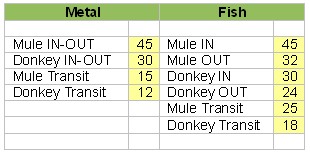
I have not verified if the duties here are the same as in the book used in Arezzo, but the book kept in Florence may be somewhat earlier, has a different structure, and, especially, I could not find any playing cards mentioned there.
A few books of the same kind as the volumes mentioned are preserved in Florence in Libreria Riccardiana,(12) but even those do not exactly correspond to the book examined in Arezzo; even in the case that one of them is dated with precision, it does not allow to extend its date to the Arezzo specimen.
I feel that this whole matter has been studied in some detail for Florence and that even printed books and articles can now be found on this topic, but I fear that the original documents kept are rather few. In any case, I have delayed to a future opportunity any further search, and have resumed my study in Arezzo.
3. Camarlingo books
3.1 Series of Camarlingo books
In the ASAr, two series of Camarlingo books have been kept, Saldi and Entrata e Uscita. We usually find a big book for each year, with many entries. This is not surprising, because all the money transitions of the Commune - a very great number of items - had to be recorded in these books.
If we intend to perform a systematic search in these books, we soon meet a couple of problems. For a few years, the corresponding books are missing. This is fortunately a seldom occurrence; more frequent is the case that the books are kept, but they have been severely damaged, so that almost nothing can be read any longer in most of their pages.
The basic difficulty is however yet another one: the handwriting is hard to read, at least for me; only someone familiar with these writings can fully profit from the corresponding information. Luckily, I did not need to make a systematic search in this case, and I could select among the various books one that I could read comfortably enough.
Taking in account the years of greatest interest, I have then selected the book of 1449-50.(13) Its contents belong to the time from 4 August 1449 to 3 February 1450. Of course, we must not forget that what can be derived from this book may not be fully representative of the situation in previous or following years. To complete this research is however again a task that I am willing to leave to any researcher endowed with more patience, time, and reading ability.
3.2 Kinds of records
In the book examined (and in other ones of the series that I have leafed through), the various money incomes have been kept separately for the main kinds of taxes. As a consequence, we find several lists, one after another in pages previously assigned to specific kinds of entries, with records inserted in chronologic order within each list.
The main reason why I had examined this book was to find the records of customs duties applied to playing cards, which entered the town from Florence, or anywhere else. As soon as I verified the situation (in this and in other books), however, I lost every hope to find data of the same kind as studied in Rome by Arnold Esch,(14) and soon abandoned the idea of performing a systematic investigation in these books.
As a matter of fact, I could verify that a similar search is not reasonable enough. It is certain that cards entered the town and that duties had to be paid for these imports. However, the records in these books are for whole cartloads of merchandise, not for individual items.
Particularly interesting I found instead another section, which I had not intended to study initially in this research: it is the section of the fines paid by people who had been condemned, because they had not respected one or another law of the town, and I will discuss this part below.
3.3 Condemnation fines in 1450 from a Camarlingo book
The cases represented here are various: people found with arms, people who had not solved some of their civic tasks, people that had blasphemed or, which is of our interest, had played card games against the Statutes.
This has opened for me again another field of study. Which were the card games forbidden by the Statutes? In this book we find just one name mentioned for all card games, Condannata, a game that had been found mentioned in Florence, and in other towns as well, everywhere forbidden. It may seem here that playing cards was condemned because it was considered as equivalent to playing Condannata.
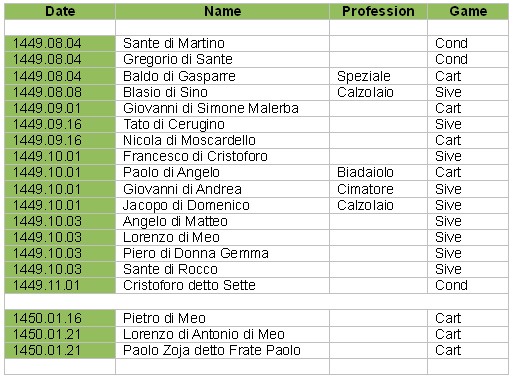
Sive is the Latin word used whenever both cards and Condannata are mentioned together, cards or Condannata; cards, namely Condannata. Cond is used in the cases where only the name of Condannata appears, Cart the same for cards.
This list is not complete and there may be several mistakes in transcribing the names from this Latin handwriting of the fines inflicted by Capitano. However, I suppose it is representative enough of the local situation of gambling at the time. The fine for card playing was 40 s., as in Florence, reduced to 30 s. if paid within the prescribed time. Seemingly, the fine was further reduced in 1450, because in that year the fine paid changes from 30s. to 20s. A few similar cases have been recorded in the section Veterum (for ex. on f. 59), but there they represent real exceptions.
It is not evident from this information if precisely this only game was still implied in the several cases in which Condannata is not explicitly mentioned, or if the card game in question could instead be different, up to the possible interpretation that any card game was prohibited (maybe with the usual conditions that one could not play within the houses or by night).
4. STATUTES AND REFORMS
Having found that card players were condemned because they had acted against the Statutes, it was logical to search what exactly was prohibited by the Statutes of Arezzo.
4.1 Arezzo Statutes and Reforms in the ASAr
Both in ASAr and ASF we find many books with the Statutes of the Arezzo Commune. They may contain the full text of a Statute, or some later Reforms to parts of it, or both items together. I have limited my attention to books containing laws of the 15th century.
The most important Statutes of the Arezzo Commune are those of 1327(15) and 1337(16). Several copies of them have been kept. We find there a law against gambling, in its typical shape of the middle ages. Of course, at that time, card playing could not be present yet, and the games prohibited were the common dice games of the Zara kind, or Çardum, as indicated here in the Latin text.
Here is the initial part of the law in the 1337 Statute, copied from a recent transcription.(16)
|
Statutum est quod omnes ludentes ad çardum vel ad alium ludum taxillorum preter quam ad aleas, ad quas ludatur tantum in loggiis et stratis et viis publicis, et loggia pubblica intelligatur locus publicus sine claudenda de die et de nocte aperta saltem a duabus partibus, et non alibi, condpnetur in X libr., et stantes ad videndum pro quolibet in tribus libris.
|
Apart from a few minor changes of words or spelling, the text of the law was the same in 1327: only the corresponding fines had been increased in the later version.
I felt it was necessary to search for following changes in this law, and this was possible in the many copies of Statuti still preserved in ASAr and ASF. The situation in Arezzo is summarised in the following Table.
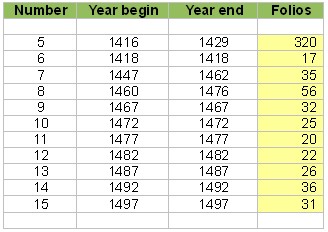
Except for the first item of the series, which I have examined without useful results, these books are very thin and expected to be of little interest - just devoted to some minor Reforms. I could find no change in the ancient law against gambling, nor any mention at all of card playing, either allowed or prohibited. It is likely that any changes in the laws against gambling was established without inserting it in the Statutes of the town.
4.2 Arezzo Statutes and Reforms in the ASF
I have thus searched whether some further information of this kind could be found in the corresponding books kept in Florence. In the ASF, I was already rather familiar with the section “Statuti delle comunità autonome e soggette”, which consists of almost one thousand books, from big towns to small villages. Precisely in this section I had studied the various laws against gambling in many Communes, practically for the same time intervals of interest here.
For Arezzo, we reasonably find several books: actually, there are no fewer than 27 books of Statutes for Arezzo, from Number 20 to number 46, including intermediate Number 22 bis. This series covers different times, and the books containing the laws of the 15th century, of our interest, are indicated below.
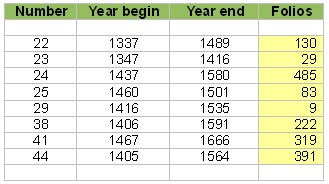
I have examined these most promising books, but could only find in the first ones of them the law against gambling in the of 1337 Statute, too early for our aims.
Many of these books contain reforms of the Statutes, but they mostly deal with reforms of the offices - how the government, the justice, and the public administration had to work - including the election conditions, the numbers and salaries of civil servants. In some cases, changes appear in punishing damages to public and private properties; sometimes, the usual (and useless) laws against too rich clothes worn by the women are updated.
Also in this group of Statutes, I was not able to find similar updates for the law against gambling.
Conclusions
In previous studies in the ASFdL unpublished data have been found for the local trade and utilisation of playing cards in the 15th century. Several uncertainty remained concerning in particular the assumption of a rather regular behaviour in the utilisation of playing cards in the course of time, or instead the presence of several periods of remarkable vogue separated by intervals with a lower spread.
Answers have thus been searched in public documents of the town. The attention has been focused on the middle of the century. First the laws on Gabelle have been studied and the amounts of the duties collected by the administration.
Later on, the study has been extended to include the laws against gambling, and again the corresponding incomes in the public cash books. In both researches, some visits to the ASF have been considered to be promising too, because many documents from Arezzo are kept in Florence.
Unfortunately, no document has been found with the necessary detail, neither for laws on gambling, nor for customs duties. It is not yet clear (to me at least) whether such documents can be found in future researches, or they have not been kept, or even not been recorded.
APPENDIX
Testatori in Ospedale di Santa Maria sopra i Ponti
Following the same guideline of most recent researches of mine, I looked, also in the ASAr, for any archival store that could contain account books of retailers. From this point of view, the ASAr is a much smaller source, in comparison with the abundant store of the ASFdL. Nevertheless, I could find five such books for the time of interest, in the section of the hospital of Santa Maria sopra i Ponti.(17)

Given the small amount of possible sources, I was not surprised to find no useful entry for our aims in those books. Rather than private documents, public ones have better to be studied here.
This situation may appear somewhat deceiving for our aims, but it may be assumed as a typical case in our public archives. Something similar had already occurred to me in other Tuscan towns, as for instance in Siena and Pistoia, where small groups of account books of retailers do exist in the corresponding sections of Archivio di Stato, in which however I could not find any record of playing cards traded.
Footnotes:
(1) Franco Pratesi 2012-13 Notes 1, 3, 4, 5, 6.
(2) archiviodistato.firenze.it
(3) Frano Pratesi: 1451 – ONE COMMON PACK OF TRIONFI, (2012)
(4) archiviostato.arezzo.it
(5) Lauretta Carbone, Personal communication, October 2012.
(6) ASAr, Tariffari, 1.
(7) ASF, Gabella dei contratti, 2250.
(8) ASF, Miscellanea della repubblica, 139.
(9) Scacco, 22 No. 4 (1991) 190-191.
(10) ASF, Statuti, 23.
(11) ASF, Miscellanea della repubblica, 138.
(12) BRF, Nos. 1848, 2434, 2526, 2604.
(13) ASAr, Camarlingo Generale – Entrata e uscita, 40.
(14) Arnold Esch, Economia, cultura materiale ed arte nella Roma del Rinascimento. Roma 2007.
(15) Statuto di Arezzo (1327) a cura di Giulia Marri Camerani, Firenze 1946.
(16) Statuto del comune e del popolo di Arezzo (1337) a cura di Valeria Capelli. Arezzo 2009.
(17) ASAr, Ospedale di Santa Maria sopra i Ponti, Libri dei Testatori, Nos. 1-5.
|
|





